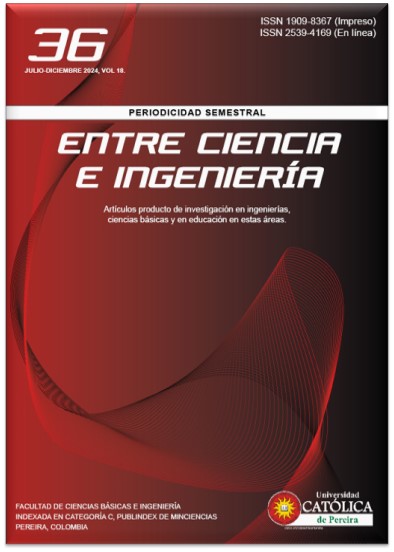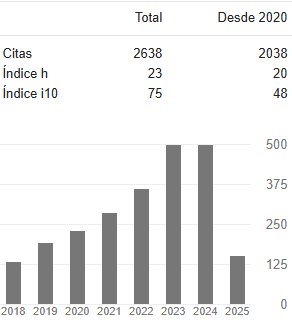Electronic system teleoperated by mobile application for the control of an omnidirectional wheelchair
DOI:
https://doi.org/10.31908/19098367.2916Palabras clave:
Aplicación móvil, control remoto, modelo matemático, plataforma móvil omnidireccional, silla de ruedasResumen
People who use wheelchairs as a displacement devicedue to their mobility limitations are repeatedly restricted by architectural and social factors. It is necessary to grant users greater autonomy and independence and the newsdevelopments in technological devices asan alternative to improve their lives. The project was executed in three phases. In the first phase,a study was made of the state of the art of omnidirectional platforms and their mathematical modeling by means of the kinematic equations of an omnidirectional mobile platform;in the second phase,the electronic system was designed and developed, finally in the third phase it covers programming, development and remote interaction between a mobile application with the wheelchair. An electronic system isdeveloped for the remote control of an omnidirectional platform adaptable to a wheelchair togrant it holonomic movements.
Descargas
Referencias
T. San Antonio, J. López Arboleda, C. Sánchez Rosero e F. Urritia, “Metodología para incentivar la inserción laboral de personas en sillas de ruedas,” Rev Univ Ind Santander Salud, pp. 47(2):215-217., 2015.
A. Gutierrez Garrido e J. F. Montoto Paredes, “Silla de Ruedas Controlada por Voz,” Asociación mexicana de Mecatrónica AC, Departamento de Ingeniería Mecatrónica, Universidad Politécnica de Pachuca, 2007.
J. Valero, “Control de una silla Robótica a través de comandos de voz,” Memorias del Congreso venezolano de BioIngenieria BIOVEN, Avances en Ingeniería Biomédica en Venezuela, 2012.
J. Alcubierre, “Silla de ruedas inteligente controlada por voz,” Primer congreso Internacional de Domótica, Robótica y Teleasistencia para todos, 2005.
M. A. Luzuriaga, “Sistema de navegación automática controlada por voz para una silla de ruedas,” Enfoque UTE 1.1, pp. 74-81, 2010. DOI: https://doi.org/10.29019/enfoqueute.v1n1.18
N. D. Lasluisa Garcés, Diseño y construcción de una silla de ruedas autónoma accionada mediante ondas cerebrales, para la asociación de limitados pléjicos de tungurahua (asoplejicat), ecuador: universidad de las fuerzas armadas espe extensión latacunga. carrera de ingeniería mecatrónica., 2015.
C. Y. Olivares Carrillo, Diseño y construcción de una interfaz cerebro computadora para el control de una silla de ruedas como ayuda a personas con discapacidad motriz., Universidad del Norte, 2017.
M. M. Morín-Castillo, A. Santillán-Guzmán, S. L. S. González e J. J. Oliveros-Oliveros, “Prototipo de Silla de Ruedas Dirigida Usando Parpadeos,” Revista mexicana de ingeniería biomédica, vol. 40, nº 1, 2019. DOI: http://dx.doi.org/10.17488/rmib.40.1.2
G. S. Buele Aguilar e S. G. Ortiz Crespo, Implementación de un sistema" Eye Tracking" para comandar una silla de ruedas eléctrica, Ecuador: Universidad del Azuay, 2019., 2019.
J. A. Arcia Hernández, Crear una silla de ruedas eléctrica de bajo costo para personas con discapacidad motriz controlada por un dispositivo manual y móvil con sistema operativo Android, Colombia: Universidad de Córdoba, 2018.
M. M. Olivo Arroyo e E. G. Gallegos Díaz, Diseño e implementación de un sistema de control electrónico de una silla de ruedas eléctrica con ubicación GPS y mando local o remoto a través de una aplicación celular android, para personas con discapacidad motriz reducida en miembros inferiores, Guayaquil: Universidad politécnica Salesiana Ecuador, 2018.
J. Noguera, “Aplicación en android para maniobrar una silla de ruedas eléctrica,” Ingeniare 21, pp. 73-91, 2016. DOI :https://doi.org/10.18041/1909-2458/ingeniare.21.399.
J. E. Mohd Salih, M. Rizon, S. Yacob, A. H. Adom e M. R. Mamat, “Designing Omni-Directional Mobile Robot with Mecanum Wheel,” American Journal of Applied Sciences 3, pp. 1831-1835, 2006. DOI: 10.3844/ajassp.2006.1831.1835.
S. Shahin, R. Sadeghian, P. Sedigh e M. T. Masouleh, “Simulation, control and construction of a four Mecanum-wheeled robo,” 2017 IEEE 4th International Conference on Knowledge-Based Engineering and Innovation (KBEI), 2017. DOI: 10.1109/KBEI.2017.8324993.
L. Kitagawa, T. Kobayashi, T. Beppu e K. Terashi, “Semi-autonomous obstacle avoidance of omnidirectional wheelchair by joystick impedance control,” Proceedings 2001 IEEE/RSJ International Conference on Intelligent Robots and Systems. Expanding the Societal Role of Robotics in the the Next Millennium (Cat. No.01CH37180), vol. 4, pp. 2148-2153, 2001. DOI: 10.1109/IROS.2001.976388.
M. Wanda, “Development of a 4WD omnidirectional wheelchair,” 2008 SICE Annual Conference, pp. 1767-1771, 2008. DOI: 10.1109/SICE.2008.4654950.
Q. Jia, M. Wang, J. G. S. Liu e C. Gu, “Research and development of mecanum-wheeled omnidirectional mobile robot implemented by multiple control methods,” 2016 23rd International Conference on Mechatronics and Machine Vision in Practice (M2VIP), pp. 1-4, 2016. DOI: 10.1109/M2VIP.2016.7827337.
I. Doroftei, V. Grosu e V. Spinu, “Omnidirectional Mobile Robot - Design and Implementation,,” Bioinspiration and Robotics Walking and Climbing Robots, Maki K. Habib, pp. 511-528, 2007. DOI: 10.5772/5518.
A. Bramanta, A. Virgono e R. E. Saputra, “Control system implementation and analysis for omniwheel vehicle,” 2017 International Conference on Control, Electronics, Renewable Energy and Communications (ICCREC), pp. 265-270, 2017. DOI: 10.1109/ICCEREC.2017.8226711.
K. Tadakuma e R. Tadakuma, “Mechanical Design of "Omni-Ball": Spherical Wheel for Holonomic Omnidirectional Motion,” 2007 IEEE International Conference on Automation Science and Engineering, pp. 788-794, 2007. DOI: 10.1109/COASE.2007.4341852.
C. Ye e S. Ma, “Development of an omnidirectional mobile platform,” 2009 International Conference on Mechatronics and Automation, pp. 1111-1115, 2009. DOI: 10.1109/ICMA.2009.5246079.
K. L. Schlee and B. A. Schlee, "Mecanum wheel". United States Patent US8960339B2, 24 February 2015.
F. Adascalitei e I. Doroftei, “Practical applications for mobile robots based on mecanum wheels - a systematic survey,” Proceedings of International Conference On Innovations, Recent Trends And Challenges In Mechatronics, Mechanical Engineering And New High-Tech Products Development –MECAHITECH’11, vol. 3, pp. 112-123, 2011.
O. Diegel, G. Bright, A. Badve, J. Potgieter e S. Tlale, “Improved Mecanum Wheel Design for Omni-directional Robots,” 2002 Australasian Conference on Robotics and Automation, pp. 117-121, 2002.
E. Maulana, M. A. Muslim e V. Hendrayawan, “Inverse kinematic implementation of four-wheels mecanum drive mobile robot using stepper motors,” 2015 International Seminar on Intelligent Technology and Its Applications (ISITIA), pp. 51-56, 2015. DOI: 10.1109/ISITIA.2015.7219952.
H. Taheri, B. Qiao e N. Ghaeminezhad, “Kinematic Model of a Four Mecanum Wheeled Mobile Robot.,” International Journal of Computer Applications, vol. 113, nº 13, pp. 6-9, 2015. DOI: 10.5120/19804-1586.
Descargas
Publicado
Número
Sección
Licencia
Derechos de autor 2025 Entre Ciencia e Ingeniería

Esta obra está bajo una licencia internacional Creative Commons Atribución-NoComercial 4.0.



















